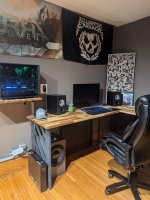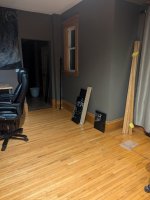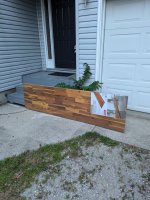Indeed, higher Qts and higher Vas. The sub would need a bigger enclosure, probably 30% more or maybe even above that.
Non responsive, please stay on topic.
Well, you've started with that ..vocabulary.. I just said not to use it.
Aside from that, I doubt the max spl is ever required because of the close distance. If a lower frequency range is needed, I'd suggest a TQWT enclosure.
Be aware that some things like hard disks do not like being thumped by sub woofer like energy and frequencies.
I did not read this entire thread, I may be saying something somebody else already did, in that case, my apologies.
Put the thing under you chair, or couch, a bit away from the actual PC.
I did not read this entire thread, I may be saying something somebody else already did, in that case, my apologies.
Put the thing under you chair, or couch, a bit away from the actual PC.
While we're at it :Aside from vibrations, hard drives also despise strong magnets.
I would like to thank each and every one of you for your replies and your insight. I have solid state hard drives and the subwoofer will be far enough alway it won't matter, I'll get a picture of the desk setup tomorrow.
I'm going to review the details posted later tomorrow when I'm back home and ready to dive back into this project. I really appreciate the time people have taken to go over the details of a project that isn't their own.
I'm going to review the details posted later tomorrow when I'm back home and ready to dive back into this project. I really appreciate the time people have taken to go over the details of a project that isn't their own.
Sorry for the delay, this week has been crazy at work and I didn't have the energy to get anywhere further with this.
I have attached a few photos including how the desk is setup showing the space I have to work with. I'm going to be using the same Acadia hardwood countertop material for the enclosure so it'll match the desk. As you can see in the photos, I have a fair bit of flexibility for placement.
For the crossover I just have a simple external Rolls SX95 and the amp is an old Behringer EP1500 that will do 400x2 into 4 ohms, I think that should be more than enough power for the application.
I have attached a few photos including how the desk is setup showing the space I have to work with. I'm going to be using the same Acadia hardwood countertop material for the enclosure so it'll match the desk. As you can see in the photos, I have a fair bit of flexibility for placement.
For the crossover I just have a simple external Rolls SX95 and the amp is an old Behringer EP1500 that will do 400x2 into 4 ohms, I think that should be more than enough power for the application.
Attachments
I would keep the speakers away from the desk, wall mounting frees up desk space and avoids resonance, you can read up what that does to electronic equipment.
Using foam isolation pads would help to reduce vibration transmission from the speakers through to the desk, and it is an inexpensive approach to the problem. These pads usually allow tilting of the speakers backwards, which will help get the speaker radiation pattern to point more directly at the listening position.
Pair of Q15s on a TPA3255, is what, maybe 150w. To which 800w of twin 10s is being added.
With talk of cab size in the air, I think a single 10 would be more than adequate. With the subs expected duty all below 180hz, some might say 200w is enough. Then turn their attention to a DSP. Perhaps just using a bru5 to put 300w out. This will help with box design, and how it works with your room. Which is an integral part of your system. One that can take a nice flat response, and stick peaks and troughs in it, that make box design look hopeless. With a car audio background, you know how different the same sub sounds in different cars. Or how some cars are great for bass, and others just disappoint. Apposing sub assemblies are a nice idea, but perhaps not the holy grail.
It's another direction to think about.
With talk of cab size in the air, I think a single 10 would be more than adequate. With the subs expected duty all below 180hz, some might say 200w is enough. Then turn their attention to a DSP. Perhaps just using a bru5 to put 300w out. This will help with box design, and how it works with your room. Which is an integral part of your system. One that can take a nice flat response, and stick peaks and troughs in it, that make box design look hopeless. With a car audio background, you know how different the same sub sounds in different cars. Or how some cars are great for bass, and others just disappoint. Apposing sub assemblies are a nice idea, but perhaps not the holy grail.
It's another direction to think about.
Backtracking through your data... The specifications of the KEF Q15 indicate that they are −3dB at 47Hz. With the two Hertz ML2500 10-inch woofers mounted in the same enclosure, each will be driven separately using the Behringer EP1500 2-channel amplifier. The available subwoofer filter is a 12dB/octave Butterworth low-pass filter.
A VituixCAD model of the above configuration is shown below. The Q15 is modelled as a 4th-order high-pass response in the simulation.

The summed response of the KEF Q15 and Hertz ML2500 with its filter set to the minimum frequency of 36Hz is shown below. The subwoofer needs to be connected with inverted polarity.

The above is not a particularly good result, as we need a peaked bass response before we get any effective bass extension.
To improve matters, what's needed is some high-pass filtering on the Q15. Here a 12dB/octave high-pass filter set to 80Hz is applied.

Now we get a much better and more extended bass response. However, because the choice of filtering isn't as good as it might be, there is a 1dB dip in the bass response between 50Hz and 200Hz, which is due to some phase cancellation. The bass response is now −3dB at about 30Hz, which is a major improvement.

A VituixCAD model of the above configuration is shown below. The Q15 is modelled as a 4th-order high-pass response in the simulation.
The summed response of the KEF Q15 and Hertz ML2500 with its filter set to the minimum frequency of 36Hz is shown below. The subwoofer needs to be connected with inverted polarity.
The above is not a particularly good result, as we need a peaked bass response before we get any effective bass extension.
To improve matters, what's needed is some high-pass filtering on the Q15. Here a 12dB/octave high-pass filter set to 80Hz is applied.
Now we get a much better and more extended bass response. However, because the choice of filtering isn't as good as it might be, there is a 1dB dip in the bass response between 50Hz and 200Hz, which is due to some phase cancellation. The bass response is now −3dB at about 30Hz, which is a major improvement.
Last edited:
- Home
- Loudspeakers
- Subwoofers
- PC desk subwoofer using car audio drivers


